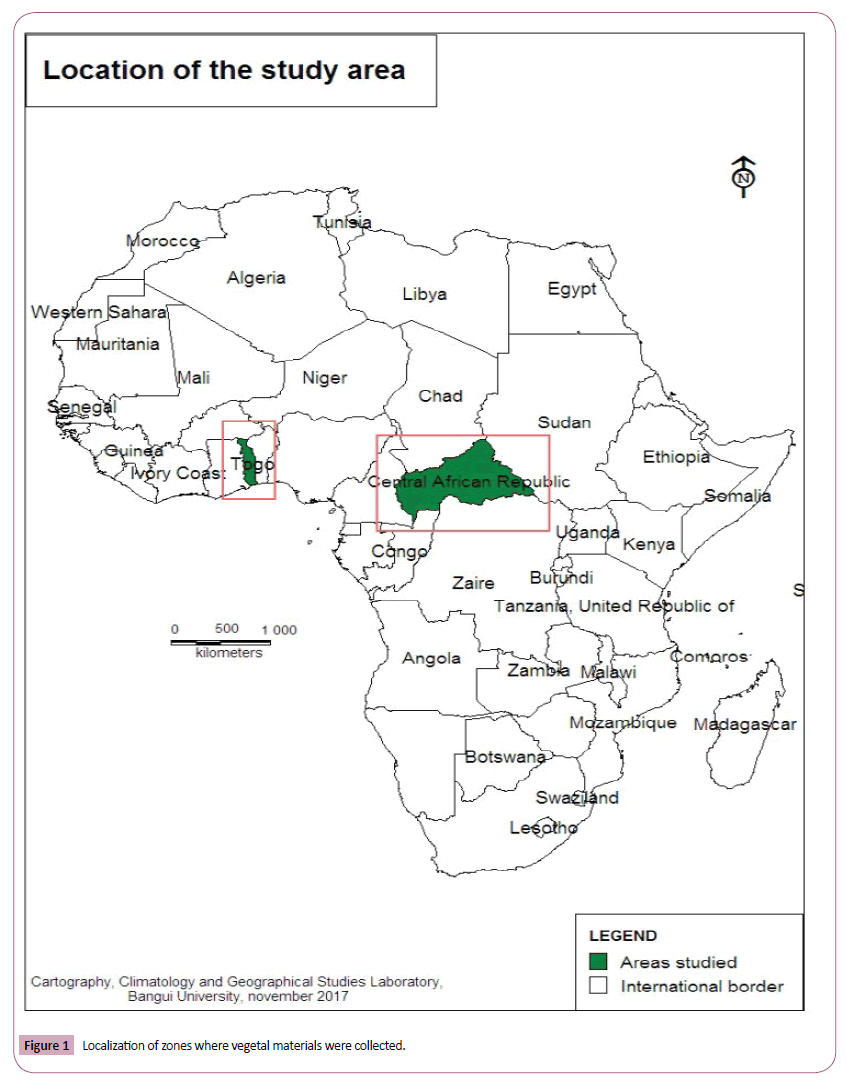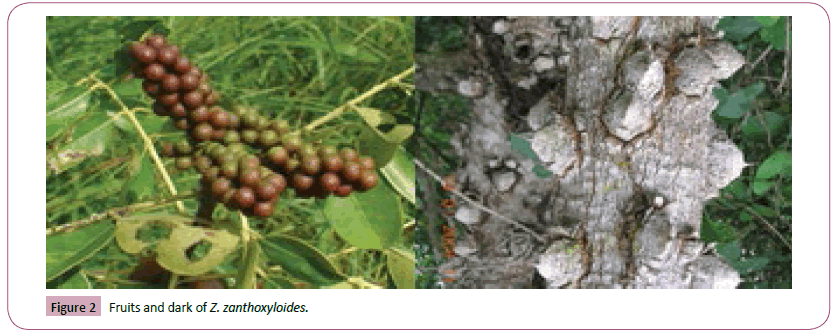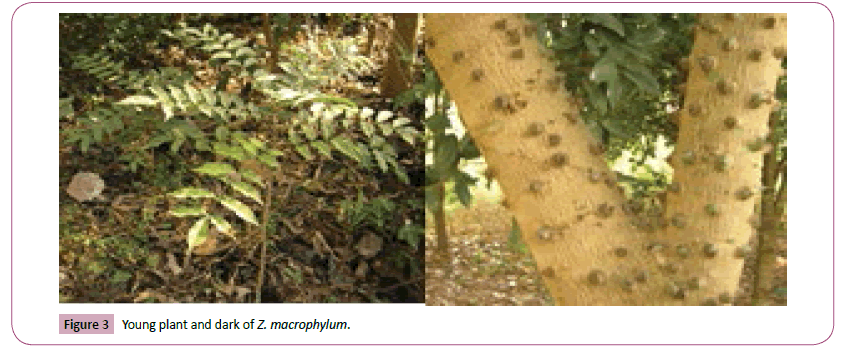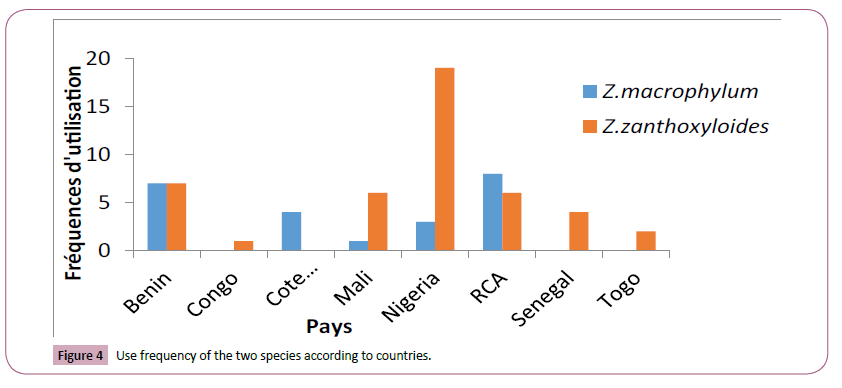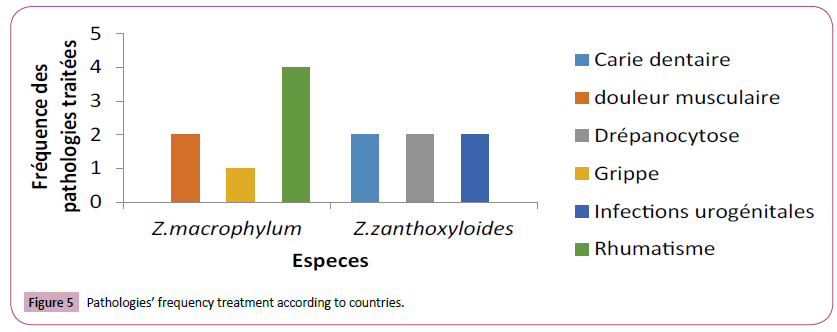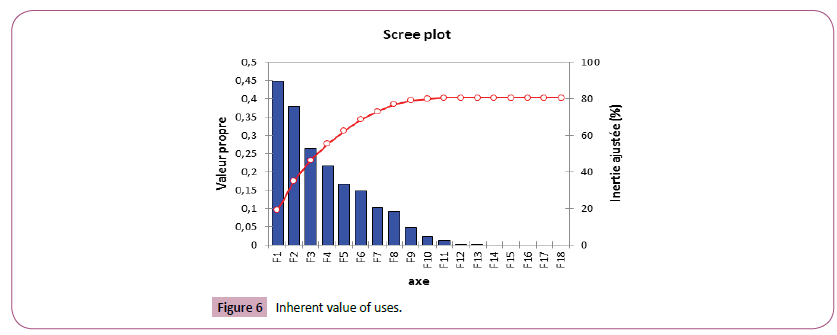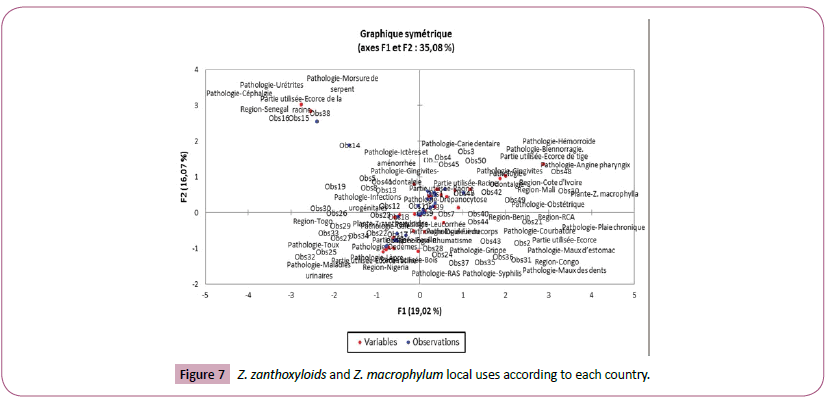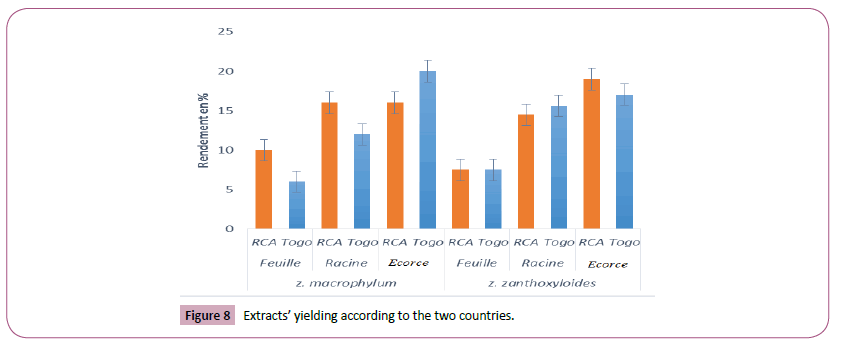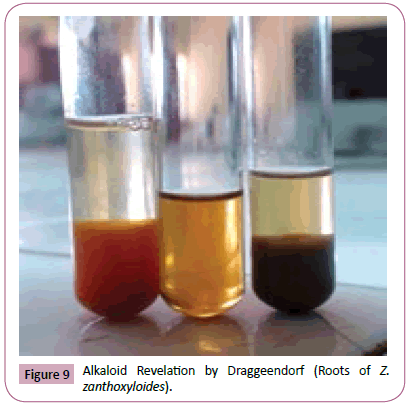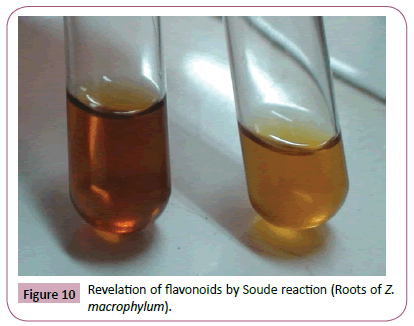ISSN : 2321-2748
American Journal of Phytomedicine and Clinical Therapeutics
Case Study and Phytochemical Investigation of Zanthoxylum zanthoxyloids and Zanthoxylum macrophylum (Rutaceae) in the Central African Republic and Togo: A Comparative Approach
Koshkomba E1,2,3*, Touckia I1, Worowounga X4, Toumnou AL1,3, Mololi A1, Mukeina G1, Semballa S1, Batawilla K2 and Akpagana K2
1Laboratory of Biological and Agronomical Sciences for Development, Bangui, Central African Republic
2Laboratory of Botanical and Vegetal Ecology, Faculty of Sciences, University of Lome, Togo, Central African Republic
3Center of Studies and Research on Pharmacopoeia and Traditional African Medicine, University of Bangui, Bangui, Central African Republic
4Laboratory of Architecture of Analysis of Reactivity of Natural Compounds (LAARSEN), Faculty of Sciences, University of Bangui, Bangui, Central African Republic
- *Corresponding Author:
- Ephrem K
Laboratory of Biological and Agronomical
Sciences for Development, Bangui, Central
African Republic
Tel: +2367789898
E-mail: koshkomba2002@yahoo.fr
Received date: December 04, 2017; Accepted date: December 11, 2017; Published date: January 16, 2018
Citation: Koshkomba E, Touckia I, Worowounga X, Toumnou AL, Mololi A, et al. (2017) Case Study and Phytochemical Investigation of Zanthoxylum zanthoxyloids and Zanthoxylum macrophylum (Rutaceae) in the Central African Republic and Togo: A Comparative Approach. Am J Phytomed Clin Ther Vol. 6 No. 1:1. doi:10.21767/2321-2748.100337
Abstract
The study carried out on Z. zanthoxyloids and Z. macrophylum, lays on the program of valorizing phytogenetical resources. It covers monographic and phytochemical study. Inner uses of these resources show as well their importance on the scale of such African countries as Nigeria, Togo, Congo, Ivory Coast, Central African Republic, Benin, Senegal and Mali. Z. macrophylum is the most used species in the treatment of rheumatism. Over all the inner practices, Z. zanthoxyloids is the most used species. Analysis in multiple correspondences (AMC) with a partial contribution of 80% shows that there is a correlation of uses over all countries, except Senegal that has specific uses. Total extracts obtains from the two specific species from the Central African and Togolese flora have various yielding according to different organs.
Keywords
Zanthoxylum zanthoxyloids; Zanthoxylum macrophylum; Monographs; Phytochemitry; CAR; Togo
Introduction
Biodiversity or diversity of being is the abundance of beauty and invention. It is also a vital resource for the human being. He takes the essential of his living from it, such as food, medicines, raw materials. Thanks to numerous interactions that living organisms tie among them and with the milieu in which they live, diversity of the beings contributes also to, from a large part, to establish and entertain the necessary conditions to maintain life on earth, such as forming the ecosystem, habitat, climatic regulation, water purification [1]. Now a days, biodiversity is threatened and we see that many plants are disappearing. The death of biodiversity would limit the discovery of new potential treatments against a great deal of diseases and other sanitary problems [2]. In many developing countries, access to conventional medicine is limited to great centers. Difficulties of moving, the least qualified staff, high cost of services and of conventional medicines and socioeconomic factors give to the great number of people, the unique choice of traditional medicine to treat their current diseases [3]. Elsewhere, some pharmaceutical medicines become more and more inefficient in front of some referential molecules, that is why it becomes necessary to continue investigating in plants in order to display new pharmaceutical properties and eventually, new molecules. Plants pertaining to same families or to neighboring families and growing in the same biotope are liable to symbolize the same chemical molecules that is why one speaks of chemotype [4]. One can explain putting forward chemotype by the fact that the same aromatic plant, botanically defined, synthetizes an extract that will be biochemically different in function of the biotope in which it grows. Thus, the nature of the soil, the altitude, sun, climatic conditions, neighboring vegetal population are elements that influence the extract produced by the plant. It is in this context that the kind Zanthoxylum (Zanthoxylum zanthoxyloids and Zanthoxylum macrophylum) interested us and is now studied. This kind has an average of more than two hundred and fifty (250) specifies, of the most aborescent and pertains to tropical countries. These plants have nervures and have secretive pockets that produce essential oils. The selection of these species is based on chimio taxinomical considerations, on its use in African traditional medicine and also on the biological results of the sifting. In Kabyè country (Togo) for example, the Z. macrophylum roots are used in soup to heal intestinal wounds and belly diseases in general. They are used generally to prepare meal for the mother. Barks are used to cure rheumatism [5]. Studies carried out in Mali and Togo on Z. zanthoxyloids show that these roots are used as teethbrushes: they cure toothache, cure infections and its’ harsh flavor is highly appreciated [4]. The timber is used for building and as toothpick. Meanwhile in Nigeria, in Benin and in the CAR, it is used to diminish the drepanocytary crisis frequencies. Its antidrepanocytary action is to render the round form to sick people’s corpuscles. In order to eradicate completely any sick people’s crisis, the dose corresponds to one gram of root’s powder to be taken three times a day [6]. Thus, the general goal of this study is to set a case study followed by a phytochemical investigation of Z. zanthoxyloids and Z. macrophylum specific to the CAR and Togo.
Materials and Methods
Site description
Site description are mentioned in the Figures 1 and 2.
Study materials
The materials are constituted of leaves; darks and roots of Z. zanthoxyloides and Z. macrophylum.
Case study
Consistent bibliographical researches gave way to get information about local uses of Z. zanthoxyloides and Z. macrophylum.
Collection and extraction of plant materials
Fresh leave, bark and root of Z. zanthoxyloides and Z. macrophylum were collected from CAR and Togo. The plants were authenticated by the taxonomist at the Department of Botany of University of Bangui and University of Togo. The identities of the plants were confirmed by comparing the voucher specimens of each plant with the herbarium specimens. Fresh leave, bark and root of Z. zanthoxyloides and Z. macrophylum were extracted in mixture solution water-alchool (50/50, alchool 95°) for 24 h and the extracts were filtered with Whatman no. 1 filter paper and concentrated to dryness at 40°C using a rotary evaporator. The extracts were re-dissolved in the same solvent to the required concentrations for the antifungal and antibacterial studies. The extraction yield was calculated using the following formula:
Weight of extract obtained Extraction yield (%)/ Weight of plant powder used × 100
Chemical assay
To identify the chemical constituents of plant extract standard procedures were followed. Freshly prepared crude extracts of Z. zanthoxyloides and Z. macrophylum were qualitatively tested for the presence of chemical constituents using the following reagents and chemicals, flavonoids with the use of Mg and HCl; Tannins with ferric chloride and potassium dichromate solutions and saponins with ability to produce stable foam and steroids with Libermann Burchard reagent, reducing sugars with Benedict’s reagent and observed color change in respective samples.
Determination of alkaloids: Test of Mayer was used for the determination of alkaloids. To 0.5 g of powdered plant material was added 15 mL of 70% EtOH. After 15 mn of sonication and 20 h stirring, the extract is allowed to stand until complete settling, followed by filtration and evaporation to dryness. The residue is taken up in a few ml of 50% HCl. The yellowing precipitate after the addition of a few drops of the Mayer reagent (potassium mercuritetraiodide), testifies to the presence of alkaloids [7,8].
Determination of saponosides: Dissolve a fraction of methanol extract in 2 mL of distilled water in a test tube for 15 mn. Stir for a few seconds in the direction of the length. The appearance of a column of water foam minus 1 cm high persisting for at least 15 mn indicates the presence of Saponosides [7].
Determination of tannins: A fraction of the methanolic and aqueous extract is dissolved in 1 mL of ethane and diluted in two mL of water. Add 2 to 3 drops of FeCl3 solution 1% or 3% in the presence of tannins, a greenish or blue coloration develops [9].
Determination of flavonoids: Total flavonoids were estimated using the method of Ordonez [10]. To 0.5 mL of sample 0.5 mL of 2% AlCl3 ethanol solution was added. After 60 min at room temperature, the absorbance was measured at 420 nm. A yellow color indicated the presence of flavonoids [11].
Statistical analysis
The data gathered have been keyboarded in a diagram under Microsoft Excel as a matrix to be analyzed (ordination and classification). These data were treated according to species, parts that were used, pathologies, use mode and countries. Multiple Correspondences’ Analysis (MCA) were realized through 2008 XLSTAT software on the date matrix containing species, used parts, pathology, use mode and country variables. The MCA allowed making a correlation between uses and countries.
Outcomes
Case study: The case study gave way to obtain data from eight (8) countries that are all African countries. These are: Benin, Congo Brazzaville, Ivory Coast, Mali, Nigeria, Central African Republic (CAR), Senegal and Togo.
Local uses according to country: Figures 3 and 4 shows Z. zanthoxyloids and Z. macrophylum use frequency in all African countries where they are signaled. Z. macrophylum is most used in Nigeria, followed by Benin, Mali, CAR, Senegal, Togo and Congo Brazzaville; but it is unknown there and is followed by Ivory Coast people. Meanwhile, Z. macrophylum is mostly used in the CAR, then in Benin, in Ivory Coast, in Nigeria, in Mali; but it is not most used in Congo, in Senegal and in Togo. Notice that use frequency varies from one country to another.
Pathologies healed: Figure 5 shows the frequency of pathologies healed by Z. zanthoxyloids, Z. macrophylum. On notices that Z. macrophylum is the most used resource in the treatment of rheumatism, followed by muscular aches and influenza. It reveals also that the frequency of Z. zanthoxyloids’ use against toothache, drepanocytosis and genital infections are the same. As for Z. macrophylum, there is variability between the frequencies of use in the treatment of pathologies.
Correlation existing between local uses: Multiple Component Analysis (MCA) done to describe the correlation between categories of local uses shows that the first three axes (F1, F 2 and F 3) contribute for 80% (Figure 6) in matter of information and that the first two axes (Figures 1 and 2) explain 35.08% of the observed variety. These two axes concentrate respectively 19.02% and 16.07% of the information (Figure 7). The MCA reveals a thin correlation between the different uses of plants in traditional healings and other uses (toothpick, wood-building), used parts together with pathologies healed according to the above listed countries. The use of the two species is almost identical in all the involved countries concerned by this study. The first group shown in Figure 7 demonstrates that there exists a high positive correlation between the different uses according to different countries, except some uses such as the use of bark and roots against snake’s bite in Senegal.
Phytochemical study
Extracts’ yielding: Figure 8 shows raw extracts’ yielding from the CAR and Togo. These yielding vary according to species and countries. The most important yielding are those from Z. macrophylum’s barks from the CAR (20%); from Z. macrophylum from Togo (19%); Zanthoxylum zanthoxyloids, Togo (17%) and 16% from Zanthoxylum macrophylum’s barks and roots from the CAR.
Phytochemical experiments: Table 1 illustrates the presence of alcaloids in Z. zanthoxyloids in the two countries. They are most present in parts from the CAR than in those from Togo. Meanwhile in Z. macrophylum, they are less present in leaves and roots from the CAR and do not exist in barks from the two countries. In Togo, alcaloids are really present in leaves and fairly in roots. Table 2 illustrates that saponosids are really present in leaves and roots from the CAR and Togolese Z. zanthoxyloids. They do not exist in barks in the CAR, but are there in a few quantities in Togo. Meanwhile, there is none in Z. macrophylum’s leaves in the two countries as well as in the CAR’s roots. In the CAR’s barks, saponosids are fairly present and weakly represented in Togo but are heavily present in the roots. Table 3 shows leaves, barks and roots of the two species from the two countries are very rich in tannins. Except that Z. zanthoxyloids’ barks and Z. macrophylum’s roots do not have any. Table 4 shows that flavonoids are present in leaves, roots and barks of the two species of the two countries. But in different proportion, mainly that it is very weak in Z. zanthoxyloids’ roots from Togo.
| Plants | Countries | Parts used | ||
|---|---|---|---|---|
| Leaves | Bark | Root | ||
| Z. zanthoxyloides | RCA | +++ | +++ | +++ |
| TOGO | +++ | ++ | ++ | |
| Z. macrophylum | RCA | + | -- | + |
| TOGO | +++ | -- | +++ | |
Table 1: Reaction with alkaloids.
| Plants | Countries | Parts used | ||
|---|---|---|---|---|
| Leaves | Bark | Root | ||
| Z. zanthoxyloides | RCA | +++ | -- | +++ |
| TOGO | +++ | + | ++ | |
| Z. macrophylum | RCA | -- | ++ | -- |
| TOGO | -- | + | +++ | |
Table 2: Reaction with saponisides.
| Plants | Countries | Parts used | ||
|---|---|---|---|---|
| Leaves | Bark | Root | ||
| Z. zanthoxyloides | RCA | +++ | -- | +++ |
| TOGO | +++ | +++ | +++ | |
| Z. macrophylum | RCA | +++ | +++ | +++ |
| TOGO | +++ | +++ | -- | |
Table 3: Reaction with tannins.
| Plants | Countries | Parts used | ||
|---|---|---|---|---|
| Leaves | Bark | Root | ||
| Z. zanthoxyloides | RCA | +++ | +++ | +++ |
| TOGO | +++ | +++ | + | |
| Z. macrophylum | RCA | ++ | ++ | ++ |
| TOGO | +++ | +++ | +++ | |
Table 4: Reaction with flavonoids.
Discussion
Zanthoxylum species are variously used in some countries. This study confirms it with an intensification and a variation in local uses of Z. zanthoxyloids in Nigeria ((20%) in regard with other countries. Meanwhile, it is not known by Ivory Coast’s people contrary to Z. macrophylum. In the CAR, Z. macrophylum’s uses are known but not in Congo Brazzaville (neighboring country). The weak use of these phylogenetic resources as fire woods, art wood, in sculpture, in pharmacopeia and as human food in Togo confirms the diversity in the use [5]. Zanthoxylum species are also differently used in traditional pharmacopeia. The obtained results indicate for example the cases of treatment in cases of toothaches, muscular aches, drepanocytosis, influenza, urogenital infections and rheumatism. Chaaib Kouri’s [4] works in Mali confirm it by the use of Z. zanthoxyloids as toothbrush (toothache); it heals infections and its hot taste is highly appreciated. Similar studies on the same pathology (toothache) realized by Paris [12] in Congo and Neetu [13] in India revealed respectively medicinal virtues of Fagara Laureiztii De Wild) and of Zanthoxylum altum. Meanwhile in Burkina Faso, Z. zanthoxyloids’ roots are proposed to non neglectable patients to VRA [3,14] as they are concerned proved that it is used in drepanocytosis prevention [15], in his investigation on Z. macrophylum, showed that roots are used in cases of gastritis, aches, rheumatism, and hemorrhoid. B arks are used in case of sore throat. Roots and leaves are indicated against toothache, headache and migraine, constipation, dysentery and fever [16]. In a recent study in the CAR proved anti-fungicidal and antibacterial properties of Z. zanthoxyloids, Z. macrophylum. All these multiform studies sustain the necessity of results Zanthoxylum species in empiric uses and fundamental researches. Case study researches allowed also showing other non therapeutic uses. This testifies the diversity in the uses of these resources. Zahoui [6] confirm it by indicating that Z. zanthoxyloids’ wood is appreciated in fish fumigation and is also used as tooth-pick when it becomes hard and though. Arbonnier [15] signals that in Nigeria and in Congo, the wood is used in building. Magico-religious uses (fumigation against evil spirits) have been also reported. Multiple Correspondence Analysis (MCA) reveals a thin correlation between the different uses according to countries. The first group shown demonstrates that there exists a high correlation between the different uses, except in Senegal that presents uses that are specific to it such as snake bite, headache and urethritis. Neetu [13] have shown that in India for example, Zanthoxylum altum is used in case of snake bite. This approach confirms not only the diversity of uses of Zanthoxylum species, but also sociocultural specificities of each people in the use of phytogenetical resources. Yielding of total extracts vary according to species together with their organs, specific to the CAR and Togo. The most important proportions are respectively those of barks: 20% (Z. macrophylum, CAR); 19% (Z. macrophylum, Togo); 17% (Z. zanthoxyloids, Togo) and 16% for Z. macrophylum’s barks and leaves from the CAR. Bossokpi [17] in a similar approach and Chaaib-kouri [4] in Mali obtained respectively such proportions as 7% and 10% from Z. zanthoxyloids’ roots’ barks and roots. This leads to think that in a case, aerial yielding and particularly barks stay higher than underground part (roots and roots’ barks). These variations can be justified by extraction techniques where high temperature during many hours may able deteriorate some such sensitive components as polyphenol which is not the case with this study where extracts are obtained after hydro-alcoholic maceration of the different organs through a rotary evaporator. These yielding variations can be explained through climatic and edaphic factors that are not to be neglected in vegetal biosynthesis, known as chemotype [3]. Phytogenetic resources generally have variability in chemical components according to the milieu. The results of phytochemical analyses show the presence of alkaloids, flavonoids, tannins and saponosids in the two species respectively in Togolese and Central African Republic flora. Meanwhile, they vary and even do not exist in some organs. Nikiéma’s works [3] confirm the presence of flavonoids (27.63%) in Z. zanthoxyloids’ roots and he even signals its richness in alkaloids. Ouédraogo [18] confirms as far as he is concerned the presence of tannins, terpenoids, alkaloids and flavonoids in Z. zanthoxyloids’ leaves, roots and stems. The results of these former researches testify the presence of molecules’ families analyzed in the case of this study. Jazet [19] in Burkina Faso was interested in another kind of Rutaceae (Citrus latifolia) and has shown alkaloids (45.26%) and Onyegba [20] in Nigeria as he is concerned, obtained 32.51% in the roots’ barks (Figures 9 and 10). Then Neng-guo [21,22] after investigating in China on Citrus unshine, obtained from the leaves, 64.44% of alkaloids. These different results allow saying that Rutaceae’s family is rich in these families of molecules and would be diversified. Pedoclimatic factors can all the more influence these phytogenetical resources’ molecular components called chemotype.
Figure 10: Revelation of flavonoids by Soude reaction (Roots of Z.macrophylum).
Conclusion
The case study and phytochemical investigations on Z. zanthoxyloids and Z. macrophylum in the CAR and Togo allow us to say that Z. macrophylum is the most used kind, mainly in the treatment of rheumatism; Z. zanthoxyloids is the kind most used with regard to the whole uses presented namely in Nigeria; Senegal is the country that has specific uses according to the different local uses of the two kinds. Total of extracts yielding vary according to kinds and their organs, specific to the CAR and Togo. The most important proportions are that of Z. macrophylum’s barks from the CAR (20%); Z. macrophylum from Togo (19%); Z. zanthoxyloids from Togo (17%) and 16% of Z. macrophylum’s barks and roots from the CAR. Phytochemical tests’ results signal the presence of alkaloids, tannins, flavonoids and saponosids in Z. zanthoxyloids and Z. macrophylum from the CAR and Togo with variations in the reactions. One can notice also a lack of reaction in some organs.
References
- Carillon A (2009) Place of phytotherapy in health systems in the 21st century.
- OMS (2002) Traditional Medicines: Growing Needs and Potential - WHO Policy Perspectives on Medicines.
- Nikiema WPR (2005) Pharmacokinetic properties of Calotropis procera a. (Asclepiadaceae) harvested in Mali: preclinical study of the anti-inflammatory and antimicrobial effects of extracts of root bark.
- Chaaib Kouri F (2004) Phytochemical investigation of an African toothbrush Zanthoxylum zanthoxyloides (Lam.) Zepernick and Timler (Syn. Fagara zanthoxyloides L.) (Rutaceae). University of Lausane, France.
- Adjonou K, Ali N, Kokutse AD, Kokou K (2010) Study of the dynamics of natural stands of Pterocarpus erinaceus Poir. (Fabaceae) overexploited in Togo. Tropical Woods and Forests 306: 9-10.
- Zahoui SO, Zirihi NG, Soro YT, Traore F (2010) Hypotensive effect of an aqueous extract of Zanthoxylum zanthoxyloides (Lam.) Waterman (Rutaceae). Phytothérapie 5: 359-369.
- Bruneton J (1999) Pharmacognosy, phytochemistry and medical plants.
- Stalikas CD (2007) Extraction, separation and detection methods for phenolic acids and flavonoids Review. J Sep Sci 30: 3268-3295.
- Harborne JB (2005) Phytochemical method. 3rd edn.
- Ordonez AAL, Gomez JD, Vattuone MA, Isla MI (2006) Antioxidant activities of Sechium edule (Jacq.) Swart extracts. Food Chem 97: 452-458.
- Lebreton P, Jay M, Voirin B (1967) On the qualitative and quantitative analysis of flavonoids. Chim Anal 49: 375-383.
- Paris M, Bouquet A, Paris R (2001) On the flavonoids of Fagara laurentii de Wild. Isolation of a flavonoid identified hesperidoside. Congo Brazzaville 5: 1-9.
- Neetu JSK, Srivastava SK, Aggarwal KK, Ramesh S, Kumar S (2001) Essential oil composition of Zanthoxylum alatum seeds from northern India. 16: 408-410.
- Ouattara B, Angenot L, Guissou P (2004) LC/MS/NMR Analysis of isomeric divanilloylquinic acids from the root bark of Fagara zanthoxyloides Lam. Phytochemistry 65: 1145-1151.
- Arbonnier M (2002) Trees shrubs and lianas from the dry areas of West Africa. 541: 160-165.
- Kosh KE, Aba TL, Zinga I, Nembara ZW (2017) Phytochemistry, antifungical and antibacterial effect of Zanthoxylum zanthoxyloïdes and Zanthoxylum macrophylum used in traditional medicine in Yaboro. 11: 9-12.
- Bossokpi IPL (2004) Study of biological activities of Fagara zanthoxylum Lam (Rutaceae). Memory de DEA 66: 14-20.
- Ouédraogo M (2001) Pharmacochemical study of aqueous macerate of the root bark of Calotropis procera Ait. used in herbal medicine for sickle cell disease in Burkina Faso. Burkina Faso.
- Jazet Dongmo PM, Tatsadjieu NL (2008) Antiradical potential and antifungal activities of essential oils of the leaves of Citrus latifolia against Phaeoramularia angolensis. Afr J Bio 7: 4045-4050.
- Onyeagba RA, Ugbogu OC, Okeke CU (2004) Studies on the antimicrobial effects of garlic (Allium sativum Linn), ginger (Zingiber officinale Roscoe) and lime. Afr J Bio 3: 552-554.
- Neng T, Yue L, Ji Z (2008) Chemical composition of essential oil from the peel of Satsuma mandarin. Int J Pharm Sci Rev Res 44: 179-184.
- Courchamp F (2009) Excerpt from the book Ecology for Dummies.

Open Access Journals
- Aquaculture & Veterinary Science
- Chemistry & Chemical Sciences
- Clinical Sciences
- Engineering
- General Science
- Genetics & Molecular Biology
- Health Care & Nursing
- Immunology & Microbiology
- Materials Science
- Mathematics & Physics
- Medical Sciences
- Neurology & Psychiatry
- Oncology & Cancer Science
- Pharmaceutical Sciences
